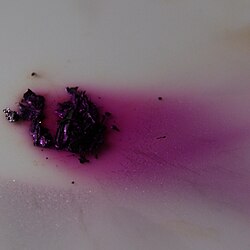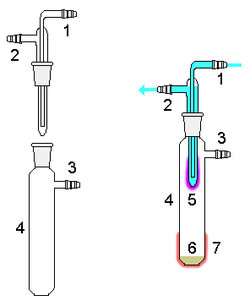Sublimation (phase transition)

Sublimation is how a solid becomes a gas without becoming a liquid first. It happens when the particles of a solid absorb enough energy to completely overcome the force of attraction between them. Most substances can sublimate only at low pressure. Many can sublimate in space.
Sometimes snow sublimates. This is usually on sunny winter days when the air is very dry. Snow may look like it disappears on a cold sunny day, but this is not sublimation because it forms a thin layer of liquid water first.
At normal atmospheric pressure on the surface of the Earth, only some compounds like dry ice (solid carbon dioxide) can go through this process. CO2 changes from dry ice, a solid to a gas without being a liquid. Also diamond, graphite, iodine, ammonium chloride and aluminium chloride sublime rather than melt at atmospheric pressure.
Sublimation (phase Transition) Media
Dark green crystals of nickelocene, sublimed and freshly deposited on a cold finger
Comparison of phase diagrams of carbon dioxide (red) and water (blue) showing the carbon dioxide sublimation point (middle-left) at 1 atmosphere. As dry ice is heated, it crosses this point along the bold horizontal line from the solid phase directly into the gaseous phase. Water, on the other hand, passes through a liquid phase at 1 atmosphere.
Dry ice subliming in air
Experimental set up for the sublimation reaction of naphthalene, solid naphthalene sublimes and form the crystal-like structure at the bottom of the watch glass
Solid compound of naphthalene sublimed to form a crystal-like structure on the cool surface.
Camphor subliming in a cold finger. The crude product in the bottom is dark brown; the white purified product on the bottom of the cold finger above is hard to see against the light background.
Crystals of ferrocene after purification by vacuum sublimation







